![]()
![]()
![]()
Use LEFT and RIGHT arrow keys to navigate between flashcards;
Use UP and DOWN arrow keys to flip the card;
H to show hint;
A reads text to speech;
41 Cards in this Set
- Front
- Back
|
Case 1: 17yo complains of fever, sore throat, enlarged neck lymph nodes, nausea, and weakness for 1 week. CBC shows leukocytosis (↑WBC count: 30,000/µL) and normal Hb and platelet count.
In order to make a diagnosis of acute leukemia, how many blasts (at minimum) would you have to see in a PB or BM smear? |
>20% or more blasts
|
|
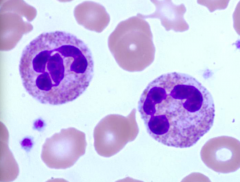
Case 1: 17yo complains of fever, sore throat, enlarged neck lymph nodes, nausea, and weakness for 1 week. CBC shows leukocytosis (↑WBC count: 30,000/µL) and normal Hb and platelet count.
The cells that appear to be numerically increased int he peripheral blood in this condition are? |
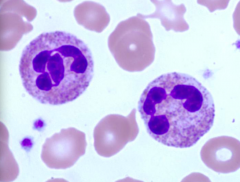
Neutrophils
|
|
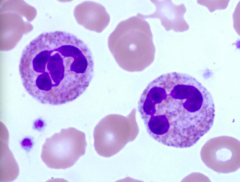
Case 1: 17yo complains of fever, sore throat, enlarged neck lymph nodes, nausea, and weakness for 1 week. CBC shows leukocytosis (↑WBC count: 30,000/µL) and normal Hb and platelet count. Elevated neutrophils (as shown in smear).
Based on these findings and the clinical presentation, what is the most likely diagnosis? |
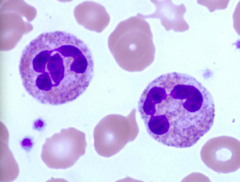
Streptococcal tonsillitis
(fits both clinical picture and smear with elevated neutrophils; neutrophilia is common in bacterial infections) |
|
|
Case 1: 17yo complains of fever, sore throat, enlarged neck lymph nodes, nausea, and weakness for 1 week. CBC shows leukocytosis (↑WBC count: 30,000/µL) and normal Hb and platelet count. Elevated neutrophils (as shown in smear).
You suspect Streptococcal tonsillitis. What laboratory test is likely to be positive and confirm the diagnosis? |
Throat culture
|
|
|
Case 1: 17yo complains of fever, sore throat, enlarged neck lymph nodes, nausea, and weakness for 1 week. CBC shows leukocytosis (↑WBC count: 30,000/µL) and normal Hb and platelet count. Elevated neutrophils (as shown in smear).
The young man mentions that his little brother has been coughing for three weeks and he may have “whooping cough”. What kind of cell type is likely to be increased in his brother’s peripheral blood? |
Lymphocytes
(This is an unusual response to a bacterial infection, usually would cause neutrophilia, but in this case Bordatella pertussis releases a toxin that stimulates LYMPHOCYTES) |
|
|
Case 1: 17yo complains of fever, sore throat, enlarged neck lymph nodes, nausea, and weakness for 1 week. CBC shows leukocytosis (↑WBC count: 30,000/µL) and normal Hb and platelet count. Elevated neutrophils (as shown in smear).
What is the significance of "toxic change" in the peripheral blood neutrophils? What does this mean? |
Indicates the presence of primary granules in neutrophils
(blue = toxic change in neutrophils, associated w/ primary granules; usually they have orange secondary granules) |
|
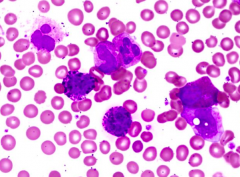
Case 2: 60yo lady w/ PMH of HTN.
↑ WBC count: 122,000/µL ↑ platelet count: 550,000/µL ↑ neutrophil count: 86,000/µL ↑ basophil count: 1,220/µL 2% blasts No history of infections, no medications, never had a CBC. Normal spleen and lymph nodes on exam. What is the most likely diagnosis based on these findings? |
Chronic Myelogenous Leukemia
- Not leukemoid reaction because no evidence of any infection - Not myelodysplastic syndrome (MDS) because usually it presents with low counts / pancytopenia (so less likely) - Not AML because <20% blasts |
|
|
Case 2: 60yo lady w/ PMH of HTN.
↑ WBC count: 122,000/µL ↑ platelet count: 550,000/µL ↑ neutrophil count: 86,000/µL ↑ basophil count: 1,220/µL 2% blasts No history of infections, no medications, never had a CBC. Normal spleen and lymph nodes on exam. She is diagnosed with Chronic Myelogenous Leukemia What does her BM most likely look like and what is the efficacy of her hematopoiesis? |
- Hypercellular BM
- Effective hematopoiesis |
|
|
Case 2: 60yo lady w/ PMH of HTN.
↑ WBC count: 122,000/µL ↑ platelet count: 550,000/µL ↑ neutrophil count: 86,000/µL ↑ basophil count: 1,220/µL 2% blasts No history of infections, no medications, never had a CBC. Normal spleen and lymph nodes on exam. She is diagnosed with Chronic Myelogenous Leukemia What finding would most likely support a diagnosis of CML? What lab tests? |
Leukocytes positive for the Philadelphia chromosome
- FISH or rtPCR or keryotyping of BM |
|
|
Case 2: 60yo lady w/ PMH of HTN.
↑ WBC count: 122,000/µL ↑ platelet count: 550,000/µL ↑ neutrophil count: 86,000/µL ↑ basophil count: 1,220/µL 2% blasts No history of infections, no medications, never had a CBC. Normal spleen and lymph nodes on exam. She is diagnosed with Chronic Myelogenous Leukemia The Philadelphia chromosome is the consequence of what translocation? Implications? |
t(9;22) - leads to BCR-ABL fusion protein
|
|
|
Case 2: 60yo lady w/ PMH of HTN.
↑ WBC count: 122,000/µL ↑ platelet count: 550,000/µL ↑ neutrophil count: 86,000/µL ↑ basophil count: 1,220/µL 2% blasts No history of infections, no medications, never had a CBC. Normal spleen and lymph nodes on exam. She is diagnosed with Chronic Myelogenous Leukemia What is the functional defect that is associated with the product of the BCR-ABL fusion gene? |
Constitutively activated tyrosine kinase
|
|
|
Chronic Myelogenous Leukemia (CML) is what kind of disorder? Characteristics?
|
- Clonal myeloproliferative disorder of pluripotent stem cells
- ↑ proliferation, ↓ apoptosis - Philadelphia chromosome - BCR/ABL fusion gene due to t(9;22) |
|
|
How common is Chronic Myelogenous Leukemia (CML)?
|
- 7-15% of adult leukemias
- ~5000 new patients / year, ~500 deaths / year |
|
|
What is the cause of Chronic Myelogenous Leukemia (CML)?
|
- Irradiation in <5%
- Unknown in 95% |
|
|
What are the phases of Chronic Myelogenous Leukemia (CML)?
|
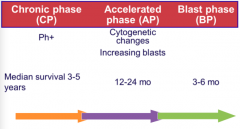
1. Chronic phase: Philadelphia chromosome +, lasts 3-5 years
2. Accelerated phase: cytogenetic changes, increasing blasts, lasts 1-2 years 3. Blast phase: lasts 3-6 months |
|
|
Case 2: 60yo lady w/ PMH of HTN.
↑ WBC count: 122,000/µL ↑ platelet count: 550,000/µL ↑ neutrophil count: 86,000/µL ↑ basophil count: 1,220/µL 2% blasts No history of infections, no medications, never had a CBC. Normal spleen and lymph nodes on exam. She is diagnosed with Chronic Myelogenous Leukemia What kind of therapy is recommended? |
*Tyrosine Kinase inhibitor (eg, Imatinib)
If this fails, try other new oral tyrosine kinase inhibitors or Stem Cell Transplant |
|
|
Case 2: 60yo lady w/ PMH of HTN.
↑ WBC count: 122,000/µL ↑ platelet count: 550,000/µL ↑ neutrophil count: 86,000/µL ↑ basophil count: 1,220/µL 2% blasts No history of infections, no medications, never had a CBC. Normal spleen and lymph nodes on exam. She is diagnosed with Chronic Myelogenous Leukemia She is treated with a Tyrosine Kinase Inhibitor and it satisfied with the her normalized WBC count. She decides to stop taking her medication. What could happen? |
Patient will likely progress to Acute Leukemia
(Stopping these drugs carries a very large risk, these patients need to take these drugs forever. Compliance is a big issue because they have to take it 2x/day for life and it is expensive. If they stop, they WILL RELAPSE.) |
|
|
Case 2b: 68 yo man with history of abdominal pain. Upper intestinal endoscopy reveals peptic ulcer disease and abdominal ultrasound demonstrates hepatic vein thrombosis and splenomegaly.
A JAK2 mutational analysis is homozygous for V617F mutation. What lab finding is likely to be present? |
*Decreased erythropoietin
Polycythemia Vera presentation: - Splenomegaly - Thrombotic events due to hyperviscosity (e.g. hepatic vein thrombosis) - Gout (increased uric acid due to increased cell breakdown) - Signs of increased histamine (released from mast cells), such as ruddy face, pruritus after bathing, or peptic ulcer disease (Increased RBC mass → down regulate Epo because they don't need to make more RBCs) |
|
|
What are the signs of Polycythemia Vera?
|
- Splenomegaly
- Thrombotic events due to hyperviscosity (e.g. hepatic vein thrombosis) - Gout (increased uric acid due to increased cell breakdown) - Signs of increased histamine (released from mast cells), such as ruddy face, pruritus after bathing, or peptic ulcer disease - Lab: ↑RBC mass → down regulation of Epo w/ normal SaO2 |
|
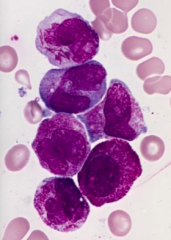
Case 3: 22yo male presents with weakness and blood oozing from nose and mouth. Petechiae and ecchymoses over most of body.
↑ WBC count: 50,000/µL, ↑ D-dimers, prothrombin time, and partial thromboplastin time, consistent w/ Disseminated Intravascular Coagulation (DIC) What is the most likely diagnosis? |
Acute Myeloid Leukemia
(high WBC and looks like myeloid cells + they contain Auer rods = AML) |
|
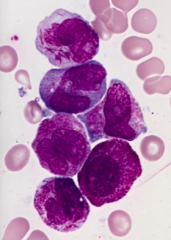
Case 3: 22yo male presents with weakness and blood oozing from nose and mouth. Petechiae and ecchymoses over most of body.
↑ WBC count: 50,000/µL, ↑ D-dimers, prothrombin time, and partial thromboplastin time, consistent w/ Disseminated Intravascular Coagulation (DIC) What cytogenetic abnormality is most likely associated with this type of AML? |
t(15;17)
= Acute Promyelocytic AML |
|
|
Case 3: 22yo male presents with weakness and blood oozing from nose and mouth. Petechiae and ecchymoses over most of body.
↑ WBC count: 50,000/µL, ↑ D-dimers, prothrombin time, and partial thromboplastin time, consistent w/ Disseminated Intravascular Coagulation (DIC) Patient is diagnosed with Acute Promyelocytic AML What is the functional defect that is associated with the product of the PML-RARα fusion gene from t(15;17)? |
A block in terminal differentiation d/t retinoic acid receptor disruption
|
|
|
Case 3: 22yo male presents with weakness and blood oozing from nose and mouth. Petechiae and ecchymoses over most of body.
↑ WBC count: 50,000/µL, ↑ D-dimers, prothrombin time, and partial thromboplastin time, consistent w/ Disseminated Intravascular Coagulation (DIC) Patient is diagnosed with Acute Promyelocytic AML What kind of therapy is recommended? |
All-trans Retinoic Acid (ATRA)
This type of AML is d/t t(15;17) which causes the PML-RARα fusion gene which blocks terminal differentiation d/t retinoic acid receptor disruption |
|
|
Case 3: 22yo male presents with weakness and blood oozing from nose and mouth. Petechiae and ecchymoses over most of body.
↑ WBC count: 50,000/µL, ↑ D-dimers, prothrombin time, and partial thromboplastin time, consistent w/ Disseminated Intravascular Coagulation (DIC) Patient is diagnosed with Acute Promyelocytic AML Which cytogenetic / molecular abnormality has a similar prognostic significance to t(15;17) in a patient w/ AML? |
All have favorable prognoses:
- t(8;21) - inv(16) - t(15;17) Intermediate to unfavorable prognosis: - 11q23 (MLL) |
|
|
What is Disseminated Intravascular Coagulation (DIC)?
|
- Disorder where patients develop overwhelming clotting, which activates their fibrinolytic system
- They run out of coagulation factors, so you are bleeding and clotting at the same time - Very hard to reverse because if you give clotting factors they will clot more and if you treat with fibrinolytics they will bleed more - 10% die within first 10 days, but after that there is a good prognosis |
|
|
How does AML w/ t(15;17) typically manifest?
|
Disseminated Intravascular Coagulation (DIC)
- Clotting and bleeding simultaneously - Can cause early morbidity and mortality |
|
|
Case 4: 76 yo woman presents with weakness and pancytopenia. BM exam shows hypercellular BM w/ frequent hypogranular and hypolobated neutrophils and small, hypolobated megakaryocytes.
What is the most likely diagnosis? |
Myelodysplastic Syndrome
(low WBCs, low Hb, low platelets) |
|
|
Case 4: 76 yo woman presents with weakness and pancytopenia. BM exam shows hypercellular BM w/ frequent hypogranular and hypolobated neutrophils and small, hypolobated megakaryocytes.
What is the most important diagnostic criterion in differentiating a Myelodysplastic Syndrome (MDS) from an Acute Myeloid Leukemia (AML) w/ myelodysplasia-associated changes? |
Bone Marrow blast percentage (if >20% it is AML w/ myelodysplasia associated changes)
|
|
|
Case 4: 76 yo woman presents with weakness and pancytopenia. BM exam shows hypercellular BM w/ frequent hypogranular and hypolobated neutrophils and small, hypolobated megakaryocytes.
Diagnosed with Myelodysplastic Syndrome. A karyotype is performed and shows abnormal findings. What cytogenetic abnormality is most likely to be found in this patient? |
- Monosomy 7 or del7q
- Monosomy 5 or del5q - Trisomy 8 |
|
|
Case 4: 76 yo woman presents with weakness and pancytopenia. BM exam shows hypercellular BM w/ frequent hypogranular and hypolobated neutrophils and small, hypolobated megakaryocytes.
Diagnosed with Myelodysplastic Syndrome. What kind of therapy is recommended? |
- Stem Cell Transplant or Supportive Care ± Growth Factors
- Hypomethylating Agents |
|
|
How do hypomethylating agents work for Myelodysplastic Syndrome?
|
- Methylation blocks gene expression
- Hypo-methylating agents remove methylating groups / block methylating agents - Allows for gene transcription to take place - Takes a few cycles to see a response, does not cure MDS, but 50% do respond to this treatment for ~2 years with improved blood counts |
|
|
Case 4: 76 yo woman presents with weakness and pancytopenia. BM exam shows hypercellular BM w/ frequent hypogranular and hypolobated neutrophils and small, hypolobated megakaryocytes.
Diagnosed with Myelodysplastic Syndrome. She is treated supportively with RBC and platelet transfusions and G-CSF. 6 months later she presents w/ 30% blasts in PB. PB flow cytometry performed and blasts are likely to be positive for what markers? |
- CD34
- CD117 - CD13 - CD33 |
|
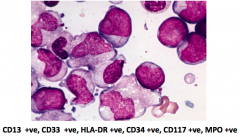
Case 5: 50 yo male presents with fatigue.
- ↓ Hb: 9 - ↑ MCV: 100 - ↓ Platelets: 30,000 - ↑ WBCs: 80,000 - ↑ Blasts: 60,000 (75%) What is the most likely diagnosis? |
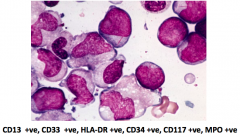
Acute Myeloid Leukemia (AML)
|
|
|
What cytogenetic abnormalities are associated with good prognoses for Acute Myeloid Leukemia (AML)? How common?
|
- t(8;21)
- t(15;17) - inv(16) - FAB type M3 (28%) |
|
|
How common are cytogenetic abnormalities associated with standard (not good or poor) prognoses for Acute Myeloid Leukemia (AML)?
|
51%
|
|
|
What cytogenetic abnormalities are associated with poor prognoses for Acute Myeloid Leukemia (AML)? How common?
|
Any patient w/ adverse karyotypic abnormalities:
- Monosomy 5 or del(5q) - Monosmy 7 - abn(3q) 20% |
|
|
How do you treat Acute Myeloid Leukemia (AML)?
|
Induction:
- "7+3" w/ Ara-C + Daunorubicin - Get 7 days of one and 3 days of the other for total of 7 days (so for 3 days 2 drugs overlap) Consolidation: - HIDAC or Ara-C |
|
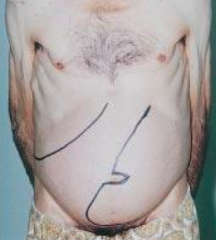
Case 6: 60yo man presents with fatigue and night sweats. Cachexia (wasting of body), bone pain.
- ↓Hb: 11gm/dl - Spleen palpable 4 cm at MCL - Teardrop cells on peripheral blood smear What lab test is likely to be positive and confirm your diagnosis? What diagnosis? |
JAK2 mutational analysis
(cause of primary myelofibrosis (PMF)) |
|
|
What are the types of Myeloproliferative Neoplasms? How common are JAK2 mutations in each?
|
- Polycythemia Vera (~100%)
- Essential Thrombocythemia (~50%) - Primary Myelofibrosis (~50%) |
|
|
Case 6: 60yo man presents with fatigue and night sweats. Cachexia (wasting of body), bone pain.
- ↓Hb: 11gm/dl - Spleen palpable 4 cm at MCL - Teardrop cells on peripheral blood smear How should this patient be treated? |
JAK2 inhibitor - treats Primary Myelofibrosis, a type of Myeloproliferative Neoplasm
|
|
|
Case 6: 60yo man presents with fatigue and night sweats. Cachexia (wasting of body), bone pain.
- ↓Hb: 11gm/dl - Spleen palpable 4 cm at MCL - Teardrop cells on peripheral blood smear How is the spleen affected in Primary Myelofibrosis? How is it affected by JAK2 inhibitors? |
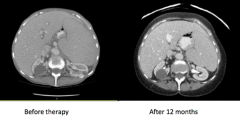
Reduction in spleen size d/t JAK2 Inhibitor treatment
|

